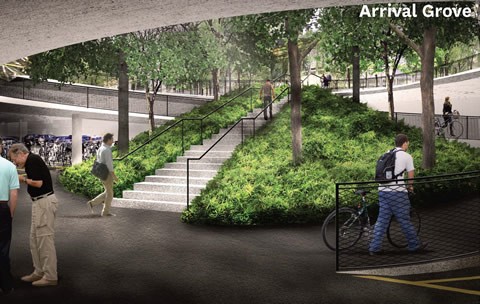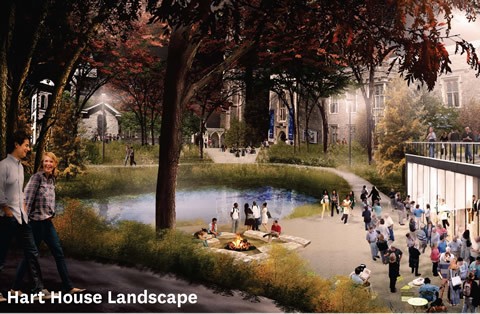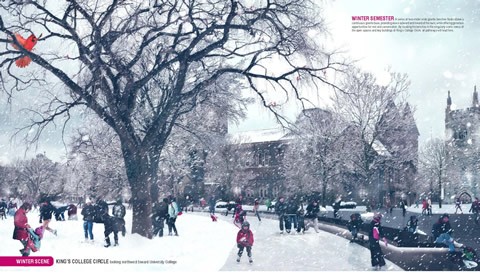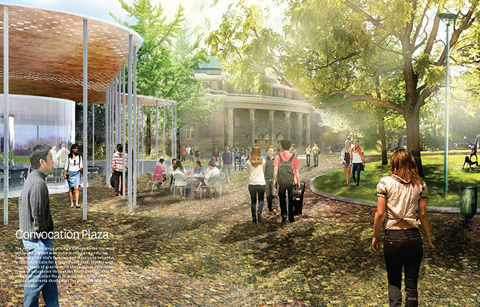A pastoral pond in front of Hart House. An elevated walkway to Queen’s Park Crescent. Public art around King’s College Circle. A skating rink outside J. Robert S. Prichard Alumni House.
These are only a few of the improvements envisioned by the four design teams shortlisted in the Landscape of Landmark Quality process aimed at renewing and restoring the historic core of the St. George campus.
The four designs will be on display for the public inside the entrance at J. Robert S. Prichard Alumni House at 21 King’s College Circle until Oct. 2. Computer terminals will be available so viewers can provide feedback on the project. The exhibition will be open from 8:45 a.m. to 6:30 p.m.
“I am immensely impressed by the flair and creativity shown by these finalists,” says Scott Mabury, U of T vice-president of operations and co-chair of the Landmark Committee overseeing the competition. “The intrinsic beauty and historic character of the St. George campus have obviously fired their imagination.
“What I find equally exciting is the collaborative process ahead. We have put the call out for feedback. Given the quality of these submissions – and the strong feelings U of T people share about the university they love – I have no doubt that there will be plenty.”
Ideas range from the necessary and pragmatic to the aesthetic and inspirational. In many cases there is a combination of these qualities.

All the plans propose underground parking in keeping with the common object of eliminating surface parking around King’s College Circle. One proposal, by Public Work + Greenberg Consultants, sees an elevated lip (called The Arc) at the southeast quadrant of King’s College Circle with flowering cherry trees on the crest and athletic faciliites (as well as sheltered bicycle and car parking) underneath. DTAH + Michael Van Valkenburgh Associates propose an “arrival grove” that will connect underground parking to the surface with both steps and a sloping accessible path rather than elevators.
Public Work and Janet Rosenberg & Studio + ArchitectsAlliance propose making a geometrically perfect circle of King’s College Circle (which at present is more amoeba-like than many suppose). DTAH and KPMB Architects also round off the corners in the interests of introducing amenities to the perimeter of this central green space. KPMB suggests an “urban necklace” of pathways around the perimeter.
“The clarity and elegance of William George Storm’s 1857 front campus has been compromised over the years by hundreds of small, well-intentioned accommodations,” notes the DTAH brief. “We propose re-establishing the clarity of the circle as a clearing in a more richly planted and expanded landscape frame.”
Three plans imagine a plaza in front of Convocation Hall. KPMB proposes multi-coloured granite surface (“expensive to install, but incredibly enduring”) in place of asphalt (the dotted blue surface installed in front of Convocation plaza in August is temporary).
An emphasis on the pedestrian experience is common to all the proposals. Among the locations considered for cafés is a terrace outside the Gerstein Science Information Centre. DTAH sees the Observatory as a tea room and proposes a new study pavilion and terrace outside Hart House.

Rosenberg, DTAH and Public Work suggest installing a pool or pond in Hart House Circle, either to the east or west of the Observatory. These plans recall McCaul’s Pond, a body of water predating Hart House.

There is no water in the KPMB plan, but there are columns of oaks along Tower Drive and its extension south of Soldiers’ Tower, as well as a dramatic pedestrian bridge in front of Hart House leading to Queen’s Park Crescent. Public Work also envisions an elevated walkway in this space.

DTAH suggests a new pavilion in the vacant space to the south of Prichard House and multi-use plaza in front of this stone building that could accommodate ice skating. Rosenberg proposes a “halo” around King’s College Circle that serves as a jogging track or ice-skating path according to season. All the plans restore the Sir Daniel Wilson Quad and all foresee more rather than fewer trees on the St. George campus.
Aesthetics have been integrated with the need for pedestrian, bicycle and limited vehicular traffic. All the plans address accessibility. “Gradations in tone and texture provide cues to bikers and pedestrians to interact safely without redundant circulation systems,” comments the brief from KPMB on the subject of the granite surface.

While some plans include glass pavilions and other modern structures, they all share a sense of tradition. “How can we make U of T more like U of T?” is how Janet Rosenberg expressed her sense of the mission. One of the most radical proposals, The Arc, is surmounted with the University of Toronto motto, Velut Arbor Aevo.
“Toronto is a winter city” remarked one questioner in a Q & A session following presentations at Con Hall on Sept. 28. Responses ranged from the positive effects of improve drainage and the potential views from “extroverted” pavilions to the simple observation that Torontonians could do a better job of celebrating winter.
Another questioner expressed concern over the cost and disruption of installing conventional parking under King’s College Circle. “We have to decide whether it is worth the disruption to achieve a pedestrianized campus,” University College Principal Donald Ainslie, co-chair of the Landmark Committee with Mabury, concluded after various team members made comments. Other questioners focused on the effect of an elevated walkway on views from the ground, the propriety of installing athletic facilities at the centre of the campus and the need for strong basic landscaping support.
After public input has been collected and considered, an evaluation committee including representatives of the Landmark Committee and university operations will choose a winner. This team will consult with the university to prepare a comprehensive design. An announcement is expected in November.
For more information go to landmark.utoronto.ca.
Recent Posts
U of T’s Feminist Sports Club Is Here to Bend the Rules
The group invites non-athletes to try their hand at games like dodgeball and basketball in a fun – and distinctly supportive – atmosphere
From Mental Health Studies to Michelin Guide
U of T Scarborough alum Ambica Jain’s unexpected path to restaurant success
A Blueprint for Global Prosperity
Researchers across U of T are banding together to help the United Nations meet its 17 sustainable development goals





